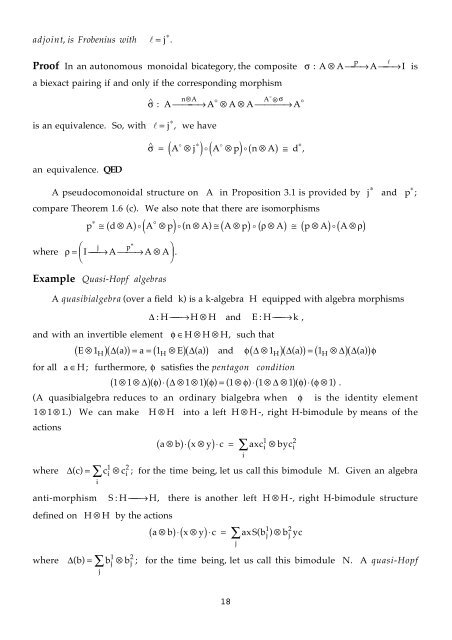Frobenius monads and pseudomonoids Introduction - ResearchGate
Frobenius monads and pseudomonoids Introduction - ResearchGate
Frobenius monads and pseudomonoids Introduction - ResearchGate
Create successful ePaper yourself
Turn your PDF publications into a flip-book with our unique Google optimized e-Paper software.
adjoint, is <strong>Frobenius</strong> with<br />
l = *<br />
j .<br />
Proof In an autonomous monoidal bicategory, the composite<br />
a biexact pairing if <strong>and</strong> only if the corresponding morphism<br />
is an equivalence. So, with<br />
an equivalence. QED<br />
o<br />
Ÿ nƒA o A ƒ s o<br />
s<br />
: A æææÆA ƒA ƒA æææÆA l = *<br />
j , we have<br />
( ) ( ƒ ) ƒ<br />
( ) @<br />
sŸ o * o<br />
*<br />
= A ƒj<br />
o A p o n A d ,<br />
p<br />
s :A ƒA æ æÆA æ æÆI l<br />
A pseudocomonoidal structure on A in Proposition 3.1 is provided by j * <strong>and</strong> p * ;<br />
compare Theorem 1.6 (c). We also note that there are isomorphisms<br />
*<br />
p @ d ƒA<br />
o A<br />
o<br />
p o( n A) A p o r A p A o A r<br />
where<br />
( ) ƒ<br />
Ê j p*<br />
ˆ<br />
r= ÁI<br />
æÆ æ A ææÆA ƒA˜.<br />
Ë<br />
¯<br />
Example Quasi-Hopf algebras<br />
( ) ƒ @ ƒ<br />
( ) ( ƒ ) @ ( ƒ ) ( ƒ )<br />
A quasibialgebra (over a field k) is a k-algebra H equipped with algebra morphisms<br />
D :H H H<br />
æÆ æ ƒ <strong>and</strong> E: H æÆ æ k ,<br />
<strong>and</strong> with an invertible element fŒH ƒH ƒH,<br />
such that<br />
( E ƒ 1H)( D( a) ) = a = ( 1H<br />
ƒE)(<br />
D(<br />
a)<br />
) <strong>and</strong> f( D ƒ 1H)( D( a) ) = ( 1H<br />
ƒ D)( D(<br />
a)<br />
) f<br />
for all a ΠH;<br />
furthermore, f satisfies the pentagon condition<br />
( 1ƒ1ƒ D) ( f) ◊ ( D ƒ1ƒ1) ( f) = ( 1ƒ f) ◊ ( 1ƒ D ƒ1)<br />
( f) ◊( f ƒ 1)<br />
.<br />
(A quasibialgebra reduces to an ordinary bialgebra when f is the identity element<br />
1 1 1<br />
ƒ ƒ .) We can make H ƒ H<br />
actions<br />
into a left H ƒ H-,<br />
right H-bimodule by means of the<br />
( a ƒ b)◊( x ƒ y)◊ c =<br />
1 2<br />
axc ƒbyc<br />
where<br />
Â<br />
i i<br />
Â<br />
i<br />
i<br />
i<br />
i<br />
1 2 ; for the time being, let us call this bimodule M. Given an algebra<br />
D( c) = c ƒc<br />
anti-morphism S: H æÆ æ H,<br />
there is another left H ƒ H-,<br />
right H-bimodule structure<br />
defined on H ƒ H by the actions<br />
( a ƒ b)◊( x ƒ y)◊ c =<br />
1 2<br />
 axS( bj) ƒbj<br />
yc<br />
where<br />
D( b) = b ƒb<br />
j<br />
Â<br />
j<br />
j j<br />
1 2 ; for the time being, let us call this bimodule N. A quasi-Hopf<br />
18<br />
is
















